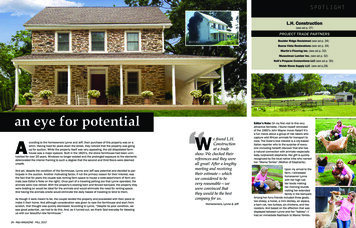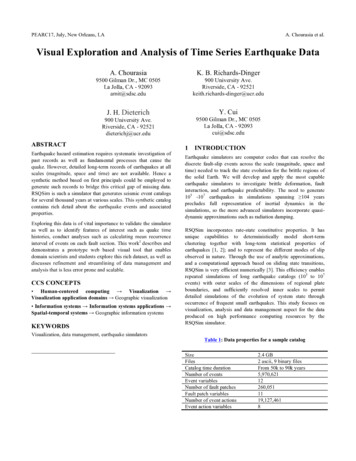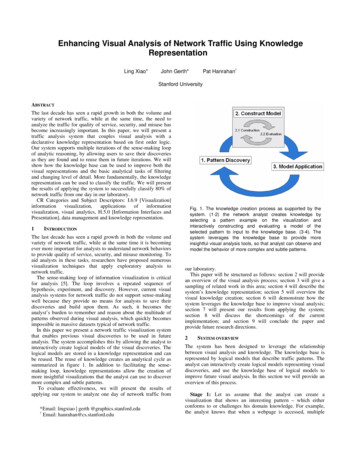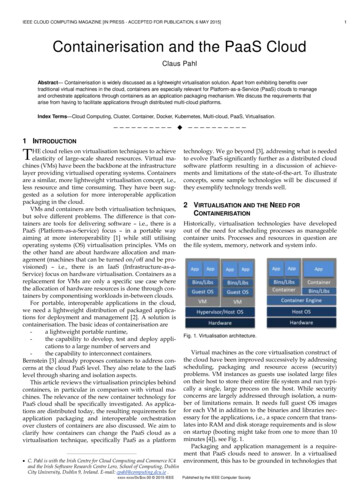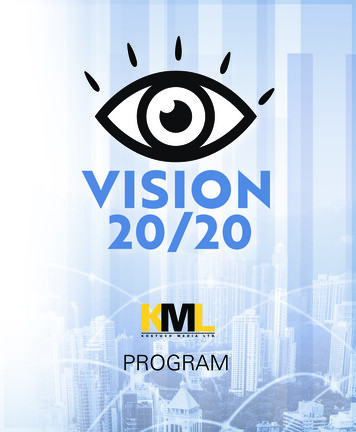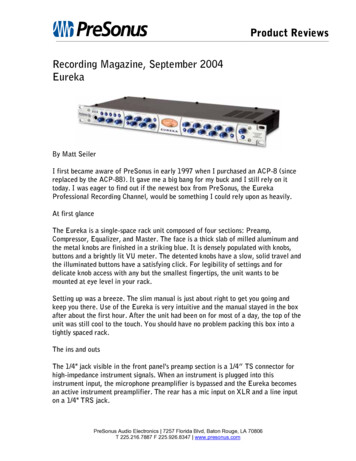
Transcription
Visual analysis of GQ magazinecovers: intersections between gender, race,and sexualityRūta LatvėnaitėDepartment of Journalism, Media and CommunicationMaster of Arts – 120 ECTSGlobal media studiesSpring term 2020Supervisor: Jörgen SkågebyDate of submission: 2020-06-12
AbstractThis thesis widens the application of intersectionality into the study of visual media. Thisstudy examines representational patterns on GQ magazine covers issued in the US withspecific regards to gender-race-sexuality intersections. Also, this study seeks to grasp whatmeaning is conveyed via those representational patterns in conjunction with the visual andlinguistic modes, and what social effect it imparts. The study employs a mixed-methodapproach combining the quantitative content analysis with the social semiotics, and the intercategorical methodological approach to intersectionality.The findings show that GQ magazine employs the same representational patternsacknowledged in culture and the magazines’ market. Those patterns manifest in the sexualobjectification of women, racial exclusion, and emphasis on white heterosexual maleness.Additionally, the intersectional analysis revealed that women of color and sexual minoritiesare in the least favorable position regarding representational patterns on GQ magazine.KeywordsVisual analysis, GQ magazine, representational patterns, representational meaning,intersectionality, intersections between gender, race and sexuality, social semiotics2
Table of ContentsAbstract . 21. Introduction . 52. Theoretical Framework and Literature review. 82.1. Gender, Race and Sexuality . 82.2. Representation and its meaning . 92.3. Representational patterns on magazine covers . 112.4. Men's magazines . 142.5. Intersectionality . 172.5.1. Intersectional black women's live experiences . 172.5.2. Intersectionality and social divisions . 192.5.3. Intersectionality in the real world. 213. Methodology . 243.1. Three methodological approaches to intersectionality: anti-, inter- and intracategorical . 253.2. Quantitative Content Analysis . 273.2.1. Sample selection. 273.2.2. Reliability . 283.3. Social Semiotics . 293.3.1. Sample selection. 303.3.2. Reliability . 314. Results and Analysis. 324.1. Results of quantitative content analysis . 324.1.1. Domination of whiteness, maleness, and heterosexuality . 324.1.2. Skin exposure . 344.1.3. Intersections of clothing, body view, and pose categories . 363
4.2. Social Semiotic Analysis and Discussion . 384.2.1. Sexual objectification of women. 384.2.2. Sharp representation of men . 434.2.3. GQ’s stereotypical representational patterns . 474.2.4. The meaning and its social effects . 495. Conclusion . 50References . 52Appendices . 554
1.IntroductionThe mass media may inform and update us about the latest events, and yet, mass media has asignificant role in visually representing reality and the world that surrounds us, showing it inphotos, images, and any other form of visual media. As Billy Hawkins (1998) states, "we livein a society where visual images are paramount and where the mass media is a powerfulmedium for perceiving reality" (Hawkins 1998:48). Additionally, Gillian Rose (2016) claimsthat "visual is central to the cultural construction of social life in contemporary Westernsocieties" (Rose 2016:1). Furthermore, following Stuart Hall's (2013) theory ofrepresentation, visuals (language, image, signs) that are socially constructed carry sociallyconstructed meaning. The magazine covers are attention-getting visuals that aim to advertiseand seduce people to purchase the publications. Additionally, being thoroughly and sociallyconstructed, magazine covers carry power and influences society.Magazine covers "provide a window into societal roles regarding whom deem to be moreimportant and of greater social value" (Wasike 2017:4). Consequently, magazine covers arecapable of conveying powerful messages with mirroring certain social constructs andascribing social roles and status for people (Wasike 2017). These processes manifest in theusing of the specific representational practises.Magazine covers have attracted a great deal of interest for media scholars. Stereotypicalgender representation, gender disparities, sexualised representation, production of fame, andcelebrity have been the main topics addressed in examining magazine covers. Previous workshave widely focused on measuring frequencies and relied on quantitative estimations.Moreover, there is a tendency to examine the depiction of women on women's magazines'covers and representation of men on magazine covers that are aimed at men. Consequently,traditionally gender categories gained a great deal of attention in the analysis ofrepresentational on magazine covers. However, other social categories, such as race andsexuality, have been neglected in the studies of visual representation. Furthermore, theresearch of representation on magazine covers tends to focus on female's magazines; thus,males' magazines are still understudied. (Lambiase and Reichert 2005)Drawing on the literature of representation, meaning-making, and intersectionality this studyaims to fill the gap in the media research and investigate how the covers of GQ (Gentlemen'sQuarterly) magazine published in the U.S., work in relation to a broader system of meaning5
by focusing on multiple axes – gender, race, and sexuality. The research aim is threefold.Firstly, this study seeks to examine representational patterns that appeared on GQ covers andquantitatively measure those patterns. Secondly, this study aims to grasp the meaning of thosepatterns by analysing the composition of visual elements and text on GQ covers. Additionally,the social effects of that specific meaning gain interest here. Thirdly, this paper recognisesthat "a different, more complex and more holistic reading of signs and symbolic orders" canbe carried out by the intersectionality approach (Barnum and Zajicek 2008:111). Theintersectionality was neglected in investigations of magazine covers in previous studies andhas not been fully addressed in analysing visual media in general. Therefore, this study seeksto investigate how intersections of gender, race, and sexuality operate in representationalpatterns and its meaning on GQ covers through the lens of intersectionality. For achievingthese aims, this study addresses the following questions:RQ1: What representational patterns are constructed on GQ covers with specific regard togender-race-sexuality intersections? Moreover, to what extent those patterns occur?RQ2: What meaning is conveyed via those representational patterns in conjunction with thecomposition of visual signs and text on GQ covers? Moreover, what is the social effect of thatmeaning with specific regard to gender-race-sexuality intersections?The mixed-methods approach that combines the quantitative content analysis with the socialsemiotic analysis, and the intersectionality approach, will be employed to answer thesequestions. Applying the intersectionality approach has been challenging since there is nocollective agreement about which social categories must be included in the analysis to make itintersectional enough. The utilisation of different racial categories varies within differentscholars and research fields. The black feminists usually apply the classical model of 'tripleoppression' (race, gender, and class) (Yuval-Davis 2006). The sociology scholars who focuson social stratification see class as the central social category (Yuval-Davis, 2015), thefeminist scholars see gender as the leading category in the intersectional analysis (Lykke2010). The intersectionality approach is both theory and method (Yuval-Davis 2006; Lykke2010; Collins and Bilge 2016). It is acknowledged here; thus, the intersectionality approach inthis study operates as a theoretical and methodological tool.6
The personal interest made an influence on choosing the topic and material for this study. Iwrote an assignment focusing on GQ covers, that employed the intersectionality approach forthe course of 'Mediatized Intersections: class, ethnicity, gender, sexuality.' I was encouragedby course teachers that this assignment has the potential for expansion into a master thesis. Ioverviewed previous studies and found out that GQ magazine covers have not gainedattention among media scholars. Moreover, a small number of researches that analysed GQcovers did not employ the intersectionality approach. These factors, together with the evidentgap in media research listed above, became a motivation for conducting this inquiry.On the whole, this study extends current knowledge of representational practices that havebeen employed in men's magazines. These practices will be examined throughintersectionality lenses. It will lead to broadening the knowledge that multiple socialcategories such as gender, race, and sexuality are interwoven that shapes representationalpractices. It is hoped that this research will contribute to widening the application of theintersectionality approach to the analysis of visual media, such as magazine covers.This section is followed by briefly introducing the defined social categories included in thisstudy. Then the theory of representation and meaning-making are presented with an overviewof previous research of visual representation on magazine covers and, specifically, men'smagazines. These sections are followed by a section that introduces the intersectionalityapproach. The next chapter explains the methodological approach and the three methods thatare applied in this study. This chapter is followed by distinguishing the results of quantitativecontent analysis and the results of social semiotics. Additionally, there is the final discussionthat brings together the results of quantitative analysis and the outcomes of social semioticanalysis. The final chapter concludes the study by emphasising the most striking results,discussing the limitations of this study, and proposing further research questions.7
2. Theoretical Framework and Literature review2.1. Gender, Race and SexualityThe social categories of gender, race and sexuality are at central in this study. Therefore, it isimportant to present how these categories are acknowledged here and will be operating in thisstudy.GenderThe gender is determined drawing on the feminist approach provided by Nina Lykke (2010).She states that feminism scholars established the intersectionality theory because they alwaysperceived gender (social category) as being intersectional. That gender "should always beconsidered in relation to its intersections with constructions of other social cultural categoriessuch as race, ethnicity, class, sexuality, age, dis/ability, nationality, and so on" (Lykke2010:50).RaceThe race here is understood as socially constructed. "Race is a legal, social, and culturalinvention rather than given in nature, and the knowledge of race and its deployment areexercises of power expressed in the encounter among groups for control over resources”(Gray 2017: 53).SexualityJeffrey Week's view of sexuality is applied to defining the term of sexuality. "Sexualiti
Visual analysis of GQ magazine covers: intersections between gender, race, and sexuality Rūta Latvėnaitė Department of Journalism, Media and Communication Master of Arts – 120 ECTS Global media studies Spring term 2020 Supervisor: Jörgen Skågeby Date of submission: 2020-06-12 . 2 Abstract This thesis widens the application of intersectionality into the study of visual media. This study .
